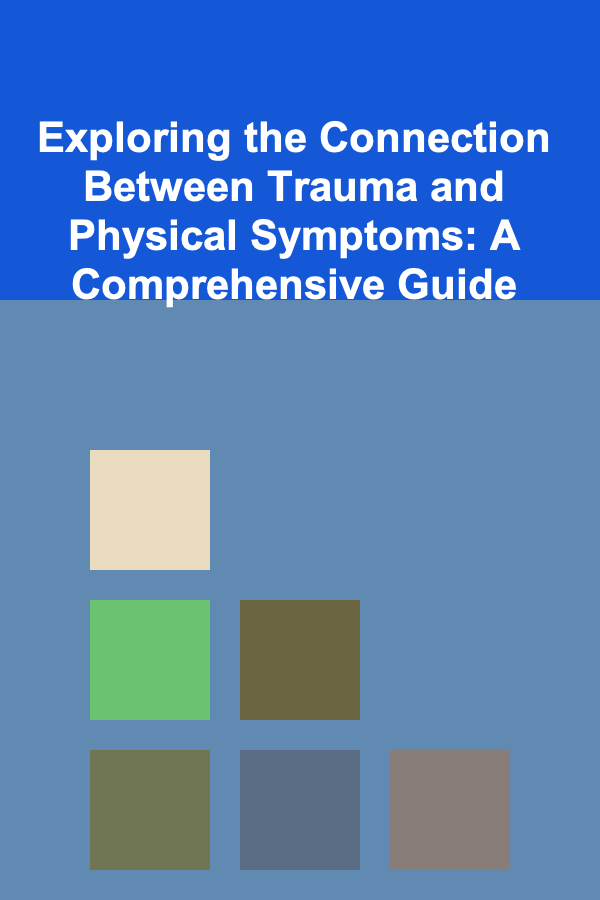
Exploring the Connection Between Trauma and Physical Symptoms: A Comprehensive Guide
ebook include PDF & Audio bundle (Micro Guide)
$12.99$8.99
Limited Time Offer! Order within the next:

Introduction: Unveiling the Mind-Body Connection After Trauma
The human experience is deeply interconnected. Our thoughts, emotions, and physical sensations are not isolated events but rather components of a complex, integrated system. This intricate relationship becomes particularly evident when considering the lasting impact of trauma. Trauma, defined as a deeply distressing or disturbing experience, can leave a profound imprint not only on our mental and emotional well-being but also on our physical health. Understanding this mind-body connection is crucial for healing and recovery.
This article delves into the multifaceted connection between trauma and physical symptoms. It explores how traumatic experiences can manifest in various physical ailments, examines the underlying biological and psychological mechanisms, and offers guidance on how to explore and address these connections in a therapeutic and self-compassionate manner. It aims to provide a comprehensive understanding for individuals seeking to heal from trauma, as well as for clinicians and caregivers supporting them.
Defining Trauma and Its Impact
Trauma is not defined by the event itself, but rather by the individual's subjective experience and the resulting impact on their ability to cope. Events that might be considered traumatic include:
- Direct Exposure: Experiencing or witnessing a life-threatening event, serious injury, or sexual violence.
- Indirect Exposure: Learning about a traumatic event that happened to a close family member or friend, especially if the event involved violence or an accident.
- Repeated Exposure: Repeated or extreme exposure to aversive details of traumatic events, such as those experienced by first responders or child protective service workers.
- Developmental Trauma: Adverse childhood experiences (ACEs) such as abuse, neglect, and household dysfunction. This type of trauma, occurring during formative years, can have particularly long-lasting effects.
The impact of trauma can be diverse and far-reaching. Beyond the immediately observable emotional distress (e.g., anxiety, depression, fear), trauma can disrupt core beliefs about safety, trust, and self-worth. It can lead to:
- Post-Traumatic Stress Disorder (PTSD): A specific mental health condition characterized by intrusive thoughts, avoidance behaviors, negative alterations in cognition and mood, and marked alterations in arousal and reactivity.
- Complex Trauma (C-PTSD): Often resulting from prolonged or repeated trauma, C-PTSD includes symptoms of PTSD along with difficulties in emotional regulation, distorted self-perception, and challenges in interpersonal relationships.
- Dissociation: A detachment from reality, including feelings of unreality, detachment from one's body (depersonalization), or detachment from one's surroundings (derealization).
- Emotional Dysregulation: Difficulty managing and expressing emotions in a healthy way, leading to outbursts, emotional numbing, or intense mood swings.
- Relationship Difficulties: Challenges forming and maintaining healthy relationships due to trust issues, fear of intimacy, or difficulties with communication.
The Body's Response to Trauma: A Biological Perspective
When faced with a perceived threat, the body initiates a complex physiological response known as the "fight-or-flight" response, mediated by the autonomic nervous system (ANS). This response is designed to prepare the individual to either confront the threat or escape from it.
The Autonomic Nervous System (ANS) and Trauma
The ANS has two main branches:
- Sympathetic Nervous System (SNS): Responsible for activating the body's stress response. When activated, the SNS triggers the release of stress hormones like adrenaline and cortisol, leading to increased heart rate, rapid breathing, muscle tension, and heightened alertness.
- Parasympathetic Nervous System (PNS): Responsible for calming the body down after a stressful event. It promotes relaxation, slows heart rate, and aids in digestion.
In individuals with a history of trauma, the ANS can become dysregulated. This means that the SNS may be chronically overactive, leading to a state of hyperarousal, or the PNS may be suppressed, making it difficult to return to a state of calm. This dysregulation can contribute to a wide range of physical symptoms.
The HPA Axis and Trauma
The hypothalamic-pituitary-adrenal (HPA) axis is another critical component of the body's stress response system. The hypothalamus releases corticotropin-releasing hormone (CRH), which stimulates the pituitary gland to release adrenocorticotropic hormone (ACTH). ACTH then signals the adrenal glands to release cortisol. Cortisol plays a vital role in regulating energy levels, immune function, and inflammation.
Chronic stress and trauma can disrupt the HPA axis, leading to either overproduction or underproduction of cortisol. This dysregulation can have significant consequences for physical health, including:
- Immune System Dysfunction: Chronic stress can suppress the immune system, making individuals more susceptible to infections and illnesses.
- Inflammation: Trauma is linked to increased levels of inflammation in the body, which has been implicated in a variety of chronic diseases, including heart disease, diabetes, and autoimmune disorders.
- Digestive Issues: The HPA axis can influence gut motility and permeability, contributing to digestive problems such as irritable bowel syndrome (IBS) and chronic constipation.
The Role of the Vagus Nerve
The vagus nerve is the longest cranial nerve in the body and plays a crucial role in regulating the connection between the brain and the body. It innervates the heart, lungs, digestive system, and other organs. The vagus nerve is a key component of the parasympathetic nervous system and is involved in promoting relaxation, reducing anxiety, and regulating the immune system.
Trauma can impair the function of the vagus nerve, leading to reduced vagal tone. Low vagal tone has been associated with:
- Increased Inflammation: The vagus nerve has anti-inflammatory properties, and reduced vagal tone can contribute to chronic inflammation.
- Digestive Problems: The vagus nerve regulates gut motility, and impaired vagal function can lead to digestive issues.
- Increased Anxiety and Depression: The vagus nerve plays a role in regulating mood, and low vagal tone has been linked to increased anxiety and depression.
Common Physical Symptoms Associated with Trauma
The physical manifestations of trauma are diverse and can vary significantly from person to person. Some of the most common physical symptoms include:
Chronic Pain
Chronic pain is a frequent complaint among individuals with a history of trauma. This pain can manifest in various forms, including:
- Headaches: Tension headaches, migraines, and cluster headaches are common.
- Back Pain: Chronic back pain, often without a clear physical cause, is frequently reported.
- Fibromyalgia: A chronic widespread pain condition characterized by fatigue, sleep disturbances, and cognitive difficulties. Trauma is a known risk factor for developing fibromyalgia.
- Joint Pain: Pain in the joints, such as knees, hips and hands, without evidence of arthritis.
The connection between trauma and chronic pain is complex. It is believed that chronic stress and inflammation, resulting from trauma-induced ANS and HPA axis dysregulation, can contribute to the development and maintenance of chronic pain conditions. Furthermore, trauma can alter pain perception, making individuals more sensitive to pain.
Digestive Issues
Trauma can significantly impact the digestive system, leading to a variety of symptoms, including:
- Irritable Bowel Syndrome (IBS): A common disorder characterized by abdominal pain, bloating, gas, diarrhea, and constipation. Trauma, particularly childhood trauma, is strongly associated with IBS.
- Chronic Constipation: Difficulty passing stools, often accompanied by abdominal discomfort.
- Nausea and Vomiting: Persistent nausea and vomiting, even in the absence of any underlying medical condition.
- Heartburn and Acid Reflux: A burning sensation in the chest caused by stomach acid flowing back into the esophagus.
The gut-brain axis plays a key role in the connection between trauma and digestive issues. Stress hormones released during trauma can alter gut motility, increase gut permeability (leaky gut), and disrupt the balance of gut bacteria (dysbiosis). These changes can contribute to inflammation and digestive symptoms.
Fatigue and Sleep Disturbances
Chronic fatigue and sleep disturbances are also common complaints among individuals with a history of trauma. These symptoms can manifest as:
- Chronic Fatigue Syndrome (CFS): A debilitating condition characterized by persistent and overwhelming fatigue that is not relieved by rest. Trauma is a known risk factor for developing CFS.
- Insomnia: Difficulty falling asleep, staying asleep, or both.
- Nightmares: Disturbing dreams that often replay the traumatic event.
- Sleep Apnea: A sleep disorder characterized by pauses in breathing during sleep.
Trauma can disrupt sleep-wake cycles and interfere with the body's natural ability to regulate sleep. Hyperarousal, anxiety, and nightmares can make it difficult to fall asleep and stay asleep. Furthermore, chronic stress can deplete energy reserves, leading to fatigue.
Cardiovascular Issues
Research suggests a link between trauma and an increased risk of cardiovascular problems, including:
- Heart Disease: Trauma, particularly childhood trauma, has been associated with an increased risk of developing heart disease later in life.
- High Blood Pressure: Chronic stress can elevate blood pressure, increasing the risk of hypertension.
- Arrhythmias: Irregular heartbeats.
Chronic stress and inflammation, resulting from trauma-induced ANS and HPA axis dysregulation, can contribute to the development of cardiovascular disease. Furthermore, trauma can lead to unhealthy lifestyle behaviors, such as smoking, poor diet, and lack of exercise, which can further increase cardiovascular risk.
Other Physical Symptoms
In addition to the above, trauma can also manifest in other physical symptoms, including:
- Dizziness and Vertigo: Feeling off balance or like the room is spinning.
- Skin Conditions: Eczema, psoriasis, hives, and other skin issues can be exacerbated by stress and trauma.
- Respiratory Problems: Shortness of breath, chest tightness, and asthma symptoms can be triggered by trauma-related anxiety and hyperarousal.
- Reproductive Issues: Menstrual irregularities, fertility problems, and sexual dysfunction can be linked to trauma.
- Weakened Immune System: Increased susceptibility to colds, flu, and other infections.
- Sensory Sensitivity: Heightened sensitivity to sounds, lights, smells, or touch.
Exploring the Connection: A Therapeutic Approach
Addressing the physical symptoms of trauma requires a holistic approach that acknowledges the interconnectedness of mind and body. It's crucial to work with qualified professionals who understand trauma and its impact on physical health.
Somatic Experiencing
Somatic Experiencing (SE) is a body-oriented therapy developed by Peter Levine. It focuses on helping individuals release trapped trauma energy from the body. SE practitioners guide clients to become aware of their physical sensations and to gently explore and release the tension and constriction that can result from trauma. The goal is to help individuals regain a sense of safety and control within their bodies.
Sensorimotor Psychotherapy
Sensorimotor Psychotherapy is another body-oriented therapy that integrates talk therapy with body awareness. It helps individuals to become more aware of their physical sensations, movements, and postures, and to understand how these patterns are related to their trauma history. Sensorimotor Psychotherapy can help individuals to develop new, more adaptive ways of relating to their bodies and to the world around them.
Eye Movement Desensitization and Reprocessing (EMDR)
While primarily known as a treatment for PTSD, EMDR can also address the physical symptoms associated with trauma. EMDR involves processing traumatic memories while simultaneously engaging in bilateral stimulation, such as eye movements, tapping, or auditory tones. This process helps to integrate the traumatic memory and reduce its emotional and physical impact.
Trauma-Informed Yoga
Yoga can be a powerful tool for healing from trauma. Trauma-informed yoga classes are specifically designed to create a safe and supportive environment for individuals with a history of trauma. These classes emphasize body awareness, mindful movement, and breathwork, which can help to regulate the nervous system and promote a sense of calm and well-being.
Mindfulness-Based Practices
Mindfulness practices, such as meditation and mindful movement, can help individuals to become more aware of their thoughts, feelings, and physical sensations in the present moment. Mindfulness can help to reduce anxiety, improve emotional regulation, and promote a sense of inner peace.
Polyvagal Theory Informed Approaches
Understanding Polyvagal Theory, developed by Stephen Porges, can be incredibly helpful. This theory outlines the vagus nerve's role in social engagement, safety, and defense mechanisms. Therapists trained in Polyvagal Theory can help clients identify and regulate their nervous system states, promoting feelings of safety and connection.
Other Therapeutic Modalities
Other therapeutic modalities that may be helpful include:
- Cognitive Behavioral Therapy (CBT): Can help identify and change negative thought patterns and behaviors that contribute to physical symptoms.
- Dialectical Behavior Therapy (DBT): Teaches skills for emotional regulation, distress tolerance, and interpersonal effectiveness.
- Art Therapy and Music Therapy: Provide creative outlets for expressing and processing trauma.
Self-Care Strategies for Managing Physical Symptoms
In addition to professional therapy, there are many self-care strategies that individuals can use to manage the physical symptoms of trauma.
Prioritize Sleep
Establish a regular sleep schedule and create a relaxing bedtime routine. Avoid caffeine and alcohol before bed. Consider using a white noise machine or earplugs to block out distracting sounds.
Nourish Your Body
Eat a healthy, balanced diet rich in fruits, vegetables, and whole grains. Avoid processed foods, sugary drinks, and excessive caffeine and alcohol. Pay attention to your body's hunger and fullness cues.
Engage in Regular Exercise
Regular physical activity can help to reduce stress, improve mood, and promote better sleep. Choose activities that you enjoy and that are appropriate for your physical abilities. Even a short walk each day can make a difference.
Practice Relaxation Techniques
Experiment with different relaxation techniques, such as deep breathing exercises, progressive muscle relaxation, and guided imagery. Find what works best for you and make time for relaxation each day.
Connect with Others
Spend time with supportive friends and family members. Join a support group for individuals with a history of trauma. Connecting with others can help to reduce feelings of isolation and loneliness.
Spend Time in Nature
Spending time in nature can have a calming and restorative effect. Take a walk in the park, sit by a lake, or simply spend some time in your backyard. Research has shown the positive impacts of "forest bathing" or simply being in green spaces.
Limit Exposure to Triggers
Identify and avoid triggers that can exacerbate your physical symptoms. This may involve limiting exposure to certain people, places, or situations. It's important to set boundaries and protect your own well-being.
Develop a Self-Soothing Toolkit
Create a toolkit of activities that you can use to soothe yourself when you are feeling overwhelmed. This may include listening to music, taking a warm bath, reading a book, or spending time with a pet.
Mindful Body Scan
Regularly check in with your body. Lie down or sit comfortably, and systematically bring your attention to different parts of your body, noticing any sensations without judgment. This practice can increase body awareness and help you identify areas of tension or discomfort.
Journaling
Writing about your experiences, feelings, and physical sensations can be a powerful way to process trauma and gain insights into the connection between your mind and body. Don't worry about grammar or structure; just write freely and honestly.
Seek Professional Support When Needed
Remember that seeking professional support is a sign of strength, not weakness. If you are struggling to manage the physical symptoms of trauma on your own, don't hesitate to reach out to a therapist or other healthcare professional.
Conclusion: Embracing Healing and Well-being
The connection between trauma and physical symptoms is complex and often overlooked. By understanding the biological and psychological mechanisms involved, and by exploring various therapeutic approaches and self-care strategies, individuals can begin to heal from the lasting impact of trauma. It's important to remember that healing is a journey, not a destination, and that progress may not always be linear. Be patient with yourself, practice self-compassion, and celebrate your successes along the way. By embracing a holistic approach that addresses both the mind and the body, individuals can move towards greater well-being and a more fulfilling life.
This article provides a starting point for understanding the complex relationship between trauma and physical symptoms. It is essential to consult with qualified healthcare professionals for personalized assessment, diagnosis, and treatment. Healing from trauma is possible, and with the right support and resources, individuals can reclaim their health and well-being.

How to Create a Digital Family Calendar for Better Coordination
Read More
How to Save Money on Home Heating and Cooling with Smart Budgeting
Read More
How to Store Bulk Purchases in an Organized and Space-Saving Manner
Read More
How to Use Multi-Purpose Furniture for Clever Storage
Read More
What Are the Most Effective Ways to Organize Your Home Library?
Read More
How to Overcome Distractions in Meditation
Read MoreOther Products

How to Create a Digital Family Calendar for Better Coordination
Read More
How to Save Money on Home Heating and Cooling with Smart Budgeting
Read More
How to Store Bulk Purchases in an Organized and Space-Saving Manner
Read More
How to Use Multi-Purpose Furniture for Clever Storage
Read More
What Are the Most Effective Ways to Organize Your Home Library?
Read More